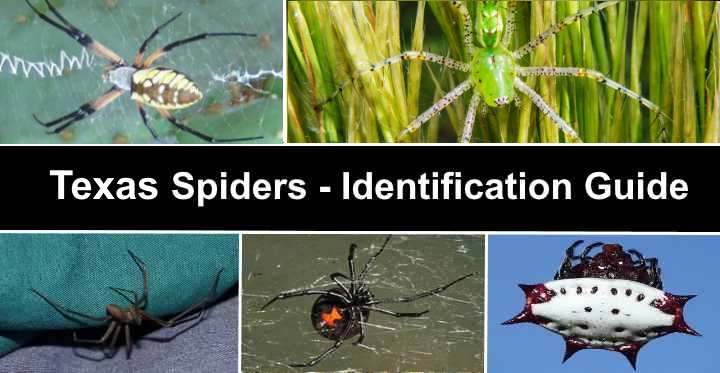Several spider species may be found in Texas, according to some estimates. You may find many different brown spiders, as well as the common Texas wolf spider and other black and white spiders, from Amarillo in the panhandle to Corpus Christi and east to Dallas and Houston. Venomous spiders are found in Texas, however they are uncommon. The majority of spiders are non-venomous.
If you reside in Texas or are visiting, knowing how to recognize spiders is important. Seeing these eight-legged creepy crawlies is rather frequent in Texas due to the hot climate and mild winters. So it’s important to know the difference between dangerous spiders and those that aren’t dangerous.
You were startled by a scurrying brown spider as it raced across the floor, and you want to know what type it is. Or, which are the most dangerous spiders in Texas? The most frequent spiders in Texas are described, illustrated, and identified in this page.
What are the Most Common Spiders in Texas
Funnel weaver grass spiders, orb weaver spiders, brown Texas recluse spiders, and Carolina wolf spiders are the most common types of spiders found in Texas. These brown and colorful spiders are most often seen outdoors, lurking in dark corners beneath logs, debris, or rocks. When the weather gets chilly, these spiders often come indoors.
What are the Most Common House Spiders in Texas
The common house spider, Texas brown widow, basement spiders, and southern house spider are the most prevalent spiders found in undisturbed areas indoors in Texas. The brown recluse and the brown widow are the two most venomous common house spiders in Texas.
How to Identify Texas Spiders
The body form and size of spiders, as well as their distinctive markings, are some of the identifying characteristics in Texas. Brown recluse and brown widow spiders, for example, might be mistaken. The brown widow, on the other hand, has a unique hourglass pattern.
The hairy body of the black and white jumping spider is a contrast. Texas spiders are arthropods in the class Arachnida, just like all other species of spiders. The eight jointed legs, a two-segmented body with an abdomen and cephalothorax, and visible mouthparts (chelicerae) differentiate them from other species. Spider antennae and wings are also absent, as are those of most insect species.
Spiders are usually only measured in terms of length when being given measurements. Yet, because they have a huge leg span, certain Texas spiders may appear to be much bigger and dangerous.
Types of Spiders Found in Texas (With Pictures) – Identification Guide
Let’s explore the distinguishing characteristics of the most popular Texas spiders that may be found around your home, in the garden, or outbuilding.
Brown Recluse Spider (Loxosceles reclusa)

The brown recluse spider (Loxosceles reclusa) is a venomous brown spider that may be found throughout the year inside. The violin pattern on the cephalothorax of the brown recluse spider is distinctive. The short jointed legs and six eyes are additional identifying characteristics. This venomous Texas spider may be blackish gray to dark brown in color.
The brown recluse spider is 0.25 to 0.5 inches (6 to 12 mm) long. This arachnoid, which is native to Texas, may be found in dark, dry, undisturbed areas with messy, irregular webs. Closets, basements, attics, and boxes are therefore rife with them. When disturbed, the brown spider scurries off despite being bitten. Localized swelling, redness, and pain are all symptoms of a brown recluse spider bite.
Texas spider identification: The brown recluse spider has a light to dark brown body with six eyes and long, outstretched legs. The violin shape on the cephalothorax’s dorsal size is what distinguishes it.
Texas Recluse Spider (Loxosceles devia)
Brown spiders found throughout Texas are known as Texas recluse spiders. A bulbous chocolate-colored body and long, translucent brown legs distinguish this native spider. This Texas spider has fiddle-shaped markings near its head, similar to those seen on the related brown recluse. The arachnoid is 0.3″ (9.5 mm) long and is sometimes known as a violin spider or fiddle-back spider.
Texas Brown Tarantula (Aphonopelma hentzi)

One of the most common hairy brown spiders in the southern US is the Texas Brown Tarantula (Aphonopelma hentzi). The large fuzzy spider has thick, sturdy pale brown or black legs and a dark brown, bulbous body. Nevertheless, because the coloration of brown tarantulas varies, determining their identification might be challenging. The leg span of Texas brown tarantula females is twice the size, ranging from 2″ to 2.25″ (50 to 57 mm).
The palm of your hand is the size of a Texas brown tarantula, according to photographs. These hairy brown spiders can be found in Texas, where they reside in burrows, beneath logs, or in grasslands. They don’t usually cause serious injury because of their enormous fangs and ability to penetrate the skin with their bite.
Texas spider identification: A hairy brown body, eight tan or black hairy legs, and a pair of fangs characterize the Texas brown tarantula.
Brown Spitting Spider (Scytodes fusca)

(Scytodes fusca) Brown Spitting Spider The brown spitting spider’s black, rounded abdomen, creamy-white to tan patterns, and long spindly legs make it an easily recognized Texas spider. Additionally, among arachnoids, this common spider features six eyes rather than the typical eight.
The cephalothorax is 0.2″ to 0.23″ (5 – 6 mm) in diameter, and its bulbous body is The gum-like substance that brown spitting spiders spit out of their mouths to catch prey earned them the moniker. They are often found in fields, beneath loose bark, or in hollowed tree trunks, even though they may be found indoors in Texas.
Texas spider identification: The dark-colored abdomen, lengthy legs, and six eyes distinguish the spitting spider. Some species have distinct patterns on their backs, while others are simply brown or black in color.
Huntsman Spider (Heteropoda venatoria)

The huntsman spider has dark blackish-gray mottled patterns on its flat, oval body. It is light to dark brown in color. The Huntsman Spider is commonly mistaken for a brown recluse because of its size and coloration. The body and leg span of this dark-colored Texas spider are larger. The huntsman spider may reach a size of 1 inch (25 mm). It also resembles one of Texas’s biggest spiders due to its huge leg span of 4″ (100 mm). The white and black markings on the spider’s long hairy legs are additional identifying features.
Because of its intolerance to cold, the huntsman spider is frequently found indoors. The huntsman spider, on the other hand, may be found outdoors year-round in Southern Texas.
Texas spider identification: The light to dark brown flattened body, grayish-brown mottled patterns, and slightly spiny hairy brownish body of the large huntsman spider distinguishes it. It also features two rows of eight black eyes.
Black and White Bold Jumping Spider (Phidippus audax)

The fuzzy Texas spider Phidippus audax has a black body and a heart-shaped mark on its abdomen. The fuzzy black legs and unusual chelicerae with an iridescent green color distinguish this jumping spider from others. Its black body is also covered in fine setae.
The little hairy spider, the bold jumping spider, is a black and white Texas spider that grows to be 0.15″ to 0.7″ (4 – 18 mm). The spider can be found outdoors in open spots in your yard, and is also known as the white-spotted jumping spider. Rather of creating webs to catch its meal, this black and white spider leaps on it.
Texas spider identification: Due to its fuzzy black body, white spots on its abdomen, and huge cephalothorax, the bold jumping spider is easy to spot in Texas landscapes.
Long-Bodied Cellar Spider (Pholcus phalangioides)
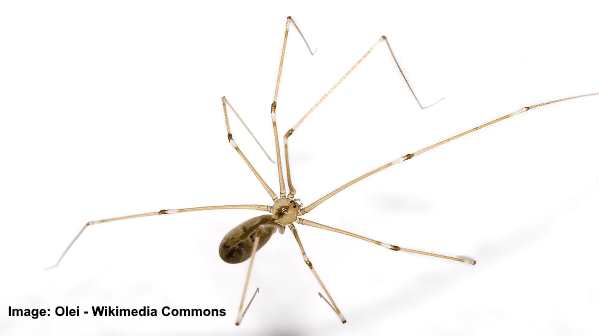
Long-bodied cellar spiders, often known as brown house spiders, are found all over Texas. The spider has long, narrow legs and a tear-shaped, slender brown body that is easily identifiable. The yellowish-brown spider species has a huge leg span despite its small size.
Daddy long-leg spiders or skull spiders are two names for these indoor spiders. Long-bodied cellar spiders can reach a length of 0.8 inch (20 mm). Their leg span, on the other hand, is up to 2.75 inches (70 mm) wide and five or six times bigger. These predatory spiders may be found in dark, poorly-lit areas of houses, such as basements, attics, garages, and even the edges of ceilings.
Texas spider identification: Because of its brown oval body and long spindly, arched legs, the long-bodied cellar spider is very easy to spot.
Gray Wall Jumping Spider (Menemerus bivittatus)

(Menemerus bivittatus) Gray Wall Spider The gray wall jumping spider is a black and gray hairy spider that lives in southern states like Florida, Texas, and California. The body of the little Texas spider is light gray-brown with black stripes along the margins. Hairy legs also have black stripes running around them. Males and females of these spiders look different, with males appearing darker and having smaller bodies.
The gray wall-jumping spider may grow to be up to 10 mm long. The gray wall jumping spider, which gets its name from being found on tree trunks or building walls in Texas, is common.
Spiders in this common Texas spider species are classified as beneficial arachnoids. The harmless gray spider preys on flies, mosquitos, and other common human pests. Additionally, they don’t create webs, meaning they are not annoying, messy indoor spiders.
Texas spider identification: The flattened body, dark color, and distinct white and gray-colored patterns distinguish the gray wall jumping spider. The gray, black-banded legs and large carapace of this spider species are also distinctive.
Pantropical Jumper Spider (Plexippus paykulli)
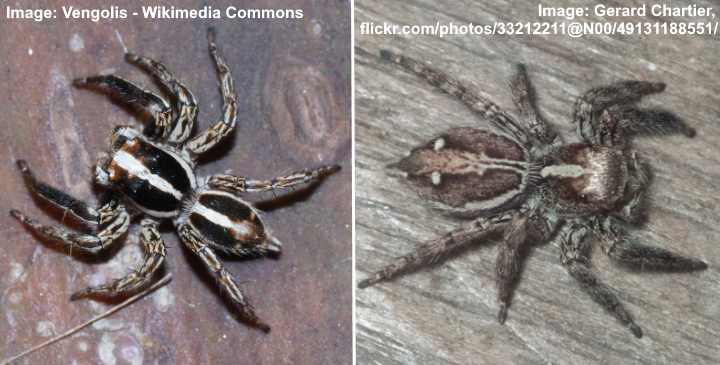
(Plexippus paykulli) Pantropical Jumper Spider The pantropical jumper, a Texas spider with large black and white stripes, is seen in this picture. The white line longitudinal down the middle of this fuzzy spider is most commonly black. Dark gray females have less visible stripes and are more uniform. Two distinct white patterns near the spinnerets distinguish the females.
0.35 to 0.43 in (9 to 11 mm) is the size of a Texas pantropical jumper spider. The male and female variants of the spider species have a notable distinction, as with many others. This spider is frequently found on the exterior of buildings, much like the related gray wall jumping spider. This spider employs stealth to capture its victim before leaping on them.
Texas spider identification: The gray to black hairs on the pantropical jumping spider give it a prominent light-colored stripe down its middle.
Texas Wolf Spider (Rabidosa rabida)

The dark brown spider with white stripes is sometimes seen in Texas homes, and is known as the Texas Wolf Spider (Rabidosa rabida). Long, slender brown legs, a three-white stripe on the cephalothorax, two marginal stripes on the dark brown abdomen, and tiny beige marks are identifying characteristics of the spider.
The Texas wolf spider grows to be 1 inch (25 mm) long and can be found all over the state. In wooded regions, cotton fields, or garbage, you’re most likely to come across the Texas wolf spider. The brown spider’s bite is harmless, even though it can bite when provoked.
Texas spider identification: The white stripes on the head and abdomen of the Texas wolf spider distinguish it from other spiders. Eight long legs and eight eyes in two rows of four make up the big hunting spider.
Common House Spider (Parasteatoda tepidariorum)
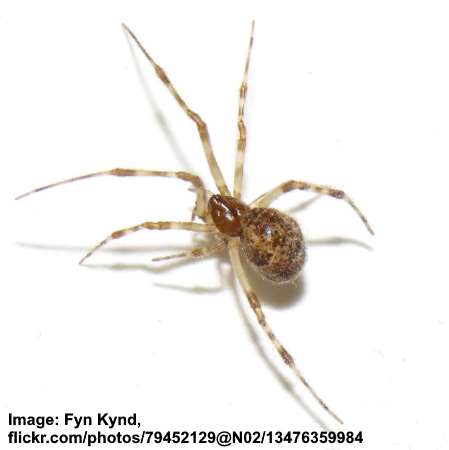
The little indoor spider Parasteatoda tepidariorum has a brown, bulging body with speckled patterns and light, banded legs. This brown spider can be found all over Texas and is often known as the American house spider. Common house spiders trap their prey in webs, which is a characteristic. Due to their body patterns, small spiders measuring 0.20 to 0.24 inches (5 to 6 mm) are difficult to detect.
The common indoor spiders, on the other hand, can measure over 1″ (25 cm) wide due to their wide leg span. House spiders are venomous, but they pose no danger to humans.
Texas spider identification: The rounded body of the common house spider is coated in white, brown, and tan pigments, with dark lines running down its sides.
Southern House Spider (Kukulcania hibernalis)

In populated areas of Texas, the southern house spider (Kukulcania hibernalis) is common. With an extended abdomen, broad, pointed legs, and eight eyes, the big southern house spider is a dark brown to black color. The two large appendages protruding from near the brown spider’s mouth are an distinguishing feature. The length of the southern house spider ranges from 0.51 to 0.74 inches (13 to 19 mm). While not as obvious as the brown recluse, several species have a head marking that is visible on a violin.
The southern house spider, like other brown house spiders, is mostly a lone spider that hides in secluded, dark spots. Brown spiders are frequently found in attics, basements, and around window sills. They’re also recognized for creating shabby, unkempt webs. Nonetheless, flies, cockroaches, beetles, and mud daubers are among the pests that appreciate these disorganized webs.
Texas spider identification: The slender dark brown or black body, fuzzy appearance, and long legs of the southern house spider are easily identifiable. Brown recluse spiders may be mistaken with these common Texas spiders.
American Nursery Web Spider (Pisaurina mira)

Pisaurina mira, a web spider from North America. The spider’s abdomen is long and slender, tapering to a point at its spinnerets, which makes it look like a stick in the right image. This orange-brown spider seems to have six legs when photographs of it are viewed with its long front two legs touching. The eight black eyes, four in a straight row and four in a curving row, create an unusual appearance.
The length of American nursery web spiders ranges from 0.47 to 0.74 inches (12 to 15 mm). It seems to be significantly bigger due to its long, straight legs. In woods, meadows, fields, shrubs, and bushes, you’re likely to come across these brown spiders. From Texas’ Rio Grande Valley to Central Florida, they’re a common sight.
Texas spider identification: The rusty brown color, thin body, and long tapering legs of the American nursery web spider are all clues to its identification.
Banana Spider (Nephila clavipes)

The banana spider is a vividly colored Texas spider with a dark brown body and creamy-white speckles. The female (left) and male (right) are shown. The abdomen of the spider darkens from a vivid orange to a reddish-brown with rows of yellowish specks as it develops. Yellow legs with dark brown stripes on them are also present in the banana spider.

Golden silk spider, calico spider, giant wood spider, or golden silk orb-weaver are all terms used to describe mature female banana spiders. The big, slender spider is 0.94–1.57 inches (24–40 mm) long and has bright colors. In warm areas across North
Carolina and the Gulf States, banana spiders are abundant. They favor gardens, where they create beautiful webs to capture prey. Banana spiders are commonly mistaken with black and yellow garden spiders because of their enormous, yellowish appearance. The biggest orb-weaver native to Texas is believed to be the banana spider.
Texas spider identification: With a little head and a brilliantly colored spotted cylindrical body, the banana spider is an excellent specimen. They have a rusty reddish-brown color with white dots and can range in color from bright yellow to brilliant white.
Black and White Spinybacked Orb-Weaver (Gasteracantha cancriformis)

One of the most unusual black and white spiders in Texas is the Black and White Spinybacked Orb-Weaver (Gasteracantha cancriformis). It has six red fleshy spines around its border and is readily noticed for its black head and legs, as well as black markings on its white belly.
The abdomen is broader than it is long, and it is white in color. The tiny outdoor spiders average 0.2 to 0.35 inch (5 to 9 mm) in length and width. This black and white spider’s scientific name is derived from its crab-like appearance. Its distinctive black or red projections on the abdomen, as well as the gorgeous orb-shaped webs they spin, are what give it its popular name.
It’s difficult to tell the difference between a spinybacked orb-weaver and a non-spinybacked orb-weaver. The spider, which dwells in shubby gardens or woodlands, is initially tiny. Additionally, the spider’s coloring might alter, with black spines appearing in some cases and a yellow, orange, or red abdomen in others. Yet, when compared to other spiders, this stunning spider has a unique look.

In southern and eastern Texas, the spinyback orb-weaver spider has a variety of colors.
Texas spider identification: The crab-like look of the spinybacked orb-weaver, as well as the white abdomen covered in black markings, helps to identify it. Around its oval abdomen, it has six distinct black or crimson pyramidal projections.
Southern Black Widow Spider (Latrodectus mactans)

The venomous Texas spider is the Southern Black Widow Spider (Latrodectus mactans). The red hourglass pattern on the underside of the black spider represents its glossy black bulbous body, black legs, and tiny head. A red patch on the abdomen at the tail end is occasionally visible.
Males are half the size of females, measuring 0.31 to 0.51 (8–13 mm) in length. From Texas to California, and north to Ohio, the southern black widow has a natural range. Undisturbed, dark places such as beneath logs, barns, attics, furniture, or in cracks are common habitats for black widows.
The webs made by black widow spiders, which are commonly found on the ground, are a sign that they’re active. When threatened or disturbed, southern black widow spiders bite. Female spiders are rarely dangerous to humans, despite the fact that they can deliver a painful bite.
Texas spider identification: The ball-shaped abdomen, glossy black color, and red hourglass mark distinguish the southern black widow spider.
Texas Brown Widow Spider (Latrodectus geometricus)

A venomous spider found in Texas, the Texas Brown Widow Spider (Latrodectus geometricus) The brown body, vividly patterned orange hourglass marking, and lengthy banded legs are all characteristics of this spider. Furthermore, the brown spider has a geometric design on its abdomen’s dorsal side that is brown and white. The Texas brown widow is smaller than typical black widow spiders, measuring 0.27 to 0.39 inches (7 to 10 mm). It is also known as geometric brown widow, gray spider, and house button spider.
The males of this spider species are dramatically smaller than the females. In the southern United States, especially Texas, the brown widow spider is common. They hide in such places as underneath building eaves, in tree hollows, and under garden debris. They prefer to lurk in dark, secluded areas. Nonetheless, in brighter places like the edges of windows and atop fences, you may also see them. Brown widow spider egg sacs, which are creamy white and spikey, are an distinguishing feature of their activity.
Texas spider identification: The dark brown color of the Texas brown widow, as well as the vivid orange hourglass marking on its underside, make it easy to spot. Tan legs, dark brown stripes, and geometric designs on its abdomen are some of the species’ distinguishing characteristics.
Yellow Garden Spider (Argiope aurantia)

The Yellow Garden Spider (Argiope aurantia) is one of the most beautiful spiders you’ll see in Texas gardens. A whitish cephalothorax, yellow legs with black stripes, and yellow markings on a black abdomen characterize this huge golden spider. The big garden spider is 0.57 to 1.1 inches (19 to 28 mm) in length.
The yellow garden spider, which is venomous, is commonly found in Texas gardens. It doesn’t bite unless it’s frightened, so it’s not an aggressive black and yellow spider. When it’s frightened, it’ll generally scurry away. Its bite, on the other hand, is as excruciating as a bumblebee sting.
The distinctive characteristic of this spider’s behavior is its eye-catching webs with a distinctive white zigzag pattern, which has also been named the zigzag spider, writing spider, or corn spider. The spider also forms a distinct ‘X’ shape while resting on the web while combining its two front legs and two back legs.
Texas spider identification: The body of the yellow garden spider is black, with distinctive yellow and gray patterns, brown to dark brown black-banded legs, and a pale-gray cephalothorax.
Arabesque Orb-Weaver Spider (Neoscona arabesca)

The arabesque orb-weaver spider is a beautiful, non-aggressive spider that may be found in Texas gardens. Males (left) and females (right) On its abdomen, the little spider has a unique pattern. With an oval abdomen and spiky legs, female orb-weavers are dark brown to black. Males are lighter and have a reddish-brown coloration.
The males are slightly smaller than the arabesque orb-weaver, which measures 0.2″ to 0.28″ (5–7 mm). One of the most prevalent orb-weavers in North America is this spider species. Spiders commonly spin webs on decorative blooming bushes and shrubs in garden settings. Male brown spiders are more likely to pursue their victims on the ground.
Texas spider identification: The ornate patterns made up of curvy dashes and short lines on the dark, rounded abdomen of the arabesque orb-weaver distinguish it. This orb-weaver species has its own set of patterns.
Dark Fishing Spider (Dolomedes tenebrosus)

The dark fishing spider (Dolomedes tenebrosus) has lighter chevron patterns and stripes on its body and legs. It is a huge dark brown spider. The oval to tear-shaped abdomen, huge brownish-gray head, and large chelicerae distinguish the spider. Males are half the size of the females, measuring 0.59 to 1.02 inch (15 to 26 mm).
This enormous brown or black spider species In terms of size and color, the dark fishing spider resembles a wolf spider. Because it favors water and even hunts for aquatic insects while walking on water, this species gets its name. They are, however, typically found in trees and occasionally enter houses.
The large size of these big hairy spiders, as well as their brown and rusty or orangey-red patterns, are two obvious characteristics. Their overall leg span is up to 3.5 inches (90 mm) thanks to their extremely long legs. The striped fishing spider (Dolomedes scriptus) looks a lot like the dark fishing spider. The striped brown spider has a lighter coloration and larger stripes than the other brown spider.
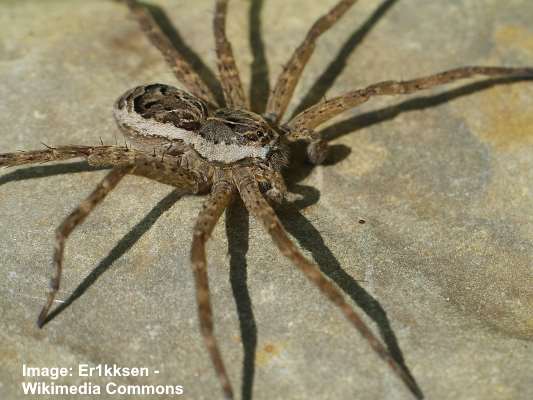
Texas spider identification: The brownish-gray color of the dark fishing spider with light brown and black markings makes it readily identifiable in Texas. The hairy legs of the spider feature alternating reddish-brown and black bands.
Carolina Wolf Spider (Hogna carolinensis)

The Carolina wolf spider, also known as Hogna carolinensis, is a big hunting spider that can be found in Texas. The females have a huge bulbous abdomen, a black cephalothorax with an orange central line, and long banded legs. The furry spider is about 2″ (25 mm) long and is the biggest species of wolf spider in North America.
Color variations exist between males and females, as do many species of spiders in Texas. The cephalothorax of male Carolina wolf spiders is lighter, and their legs are tan-colored. The abdomen, in particular, is much smaller than the head.
The Carolina wolf spider exhibits hunting behavior rather than web spinning. Little burrows inhabited by spiders, which wait for tiny insects or invertebrates to be caught, are where they dwell. They may sometimes invade homes on their own. The venomous dark brown spider does not bite humans, despite the fact that it is poisonous. Instead, it uses its venom to capture and kill cockroaches and other insects, which are common household pests.
Texas spider identification: With a hairy, dark brown body, orange stripe on its head, and mottled or banded legs, the Carolina wolf spider is a huge, harmless spider.
American Grass Spider (Agelenopsis naevia)

In Texas, the American grass spider (Agelenopsis naevia) is a brown-headed spider with three white stripes and a grayish abdomen with mottled patterns. The American grass spider’s eight eyes, arranged in three rows, spinning funnel-like webs, and remarkable speed are among the traits that distinguish it.
The length of the American grass spider is up to 0.75 inches (19 mm). The arachnoid, as a kind of grass spider, is commonly observed scurrying through yards after prey. The non-sticky web of the brownish, white-striped spider, on the other hand, is usually found at the funnel end. This common grass spider, like the American nursery web spider or wolf spider, is frequently confused with the Texas cotton grass spider.
Texas spider identification: The three white bands on the brown cephalothorax, the indistinct black bands on the grayish belly, and the brown spiny legs of the American grass spider should be visible.
Green Lynx Spider (Peucetia viridans)

The green lynx spider, Peucetia viridans, is a tropical garden spider that can be found throughout Texas. A lime green body, a narrow tapering abdomen with six chevron brown stripes, and a few brown-reddish dots characterize the bright green spider. The long, black spines on the legs of the Texas spider make it stand out. It is a green color. Males are nearly half the size of females, measuring 0.87″ (22 mm).
The spider can change its abdomen to a pale yellow with red streaks if it is in a hurry. Garden landscapes are home to the vividly hued green spider. Rather than using webs, it has keen eyesight that allows it to hunt its prey. The darting motions of this unusual green spider will distinguish it in your yard.
Texas spider identification: The bright green body, crimson dots, brownish abdominal stripes, and pale green to yellow legs with numerous black spines distinguish the green lynx spider from other garden spiders. There are also black spots on the pale-yellow legs.
Trapdoor Spider (Ctenizidae ummidia)

The trapdoor spider has a bulging bulbous abdomen, glossy black legs, and two prominent chelicerae. It is a stout, black spider with a bulging bulbous abdomen. These black spiders resemble little tarantulas, according to photographs from Texas.
Garden spiders are 0.59 to 0.70 inches (15 to 18 mm) long and dwell in ground burrows, measuring from 0.59 to 0.70 inch (15 to 18 mm). The unique habit of these black hairy spiders of building a cork-like seal to their burrows earned them the name. Little black arachnoids ambush tiny insects as they come along.
Texas spider identification: The jet-black hairy abdomen and brilliant black spiny legs distinguish the black trapdoor spider.
Tropical Orb-Weaver (Eriophora ravilla)

Eriophora ravilla, also known as the tropical orb-weaver, is a brown spider with white-tan hairs. The heart-shaped abdomen, thin reddish-brown cephalothorax, and black legs of this Texas spider set it apart. Males are half the size of females, measuring 0.47 to 0.94 inches (12 to 24 mm).
Because they come in so many colors, identifying tropical orb-weavers correctly can be challenging. A layer of fine, white setae may be found on certain dark brown individuals. Some species, on the other hand, have rounded abdomens with white patches or streaks. Yet, in comparison to their heads, all tropical weavers have enormous bellies.
Texas spider identification: A huge reddish-brown fuzzy spider with a rounded, oval abdomen and a tiny head, the tropical orb-weaver is one of its kind.
Humpbacked Orb-Weaver (Eustala anastera)

The humpbacked orb-weaver is a tan to light-brown spider with a triangular abdomen and a prominent black central stripe. It is known by its Eustala anastera name. This tiny spider has a hairy look due to its coating of small setae, similar to other orb-weavers.
It also has scalloped edges, a speckled look, and two white dots on its back. The females are 0.19 to 0.39 inch (5 to 10 mm) long when mature. Nocturnal spiders such as the humpbacked orb-weaver may be found in marshes, fields, and pine woodlands. The spider’s distinctive two or three humps on the backs of females earned it the name.
Texas spider identification: The triangle-shaped abdomen of the humpbacked orb-weaver, which is widest at the cephalothorax and pointed in the back, is very easy to spot. It stands out among other orb-weavers with a broad black band in the middle of its tan-colored abdomen.
White-Banded Crab Spider (Misumenoides formosipes)

Because of its crab-like appearance and white coloring, the White-Banded Crab Spider (Misumenoides formosipes) is an unusual Texas spider. The rounded triangular abdomen, white and brown legs, and white band in the middle of its head are all distinctive characteristics of this crab spider.
These little spiders are 0.2 to 0.44 inches (5 to 11 mm) long. White crab spiders have the ability to change their color body. These may range in color from light brown or yellow depending on the flower color they are eating. Although white is the most popular, they can also be light brown or yellow. Their body markings might likewise be black, red, or brown.
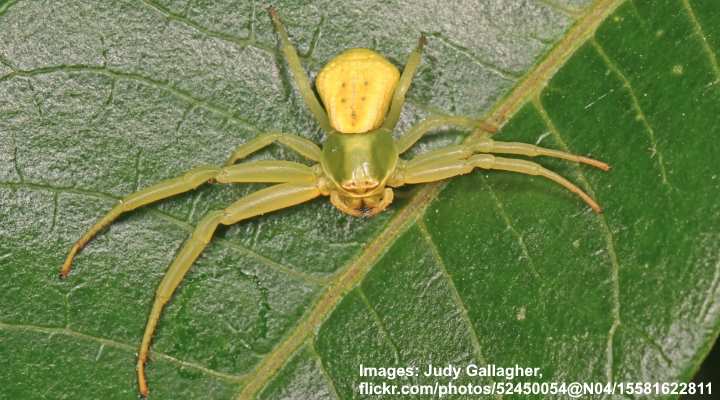
Texas spider identification: The white color and body shape of the white-banded crab spider, as well as the position of its front legs, make it simple to identify.
